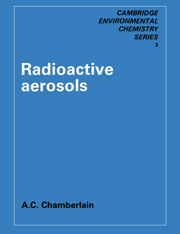Summary
5.1 Formation of plutonium aerosols
Plutonium is a man-made element, and only infinitesimal traces occur naturally. It melts at 641°C and boils at 3330°C. 239Pu is formed in nuclear reactors by neutron capture in 238U, followed by two successive beta decays (Fig. 5.1). Further neutron captures lead to 240Pu and 241Pu. 238Pu is formed from 239Pu by (n,2n) reactions, or from 235U by three successive neutron captures and two beta decays. Table 5.1 shows the half-lives, alpha and X-ray energies of the principal Pu isotopes.
Plutonium aerosols can be formed in various ways, including:
(a) Oxidation or volatilisation of Pu metal.
(b) Oxidation or volatilisation of irradiated U or UO2.
(c) Droplet dispersion from aqueous solutions or suspensions of Pu.
(d) Resuspension of soil or dust which has become contaminated with Pu.
The particle size of Pu aerosols is very variable, depending on the mode of formation. In Fig. 5.2, curves A, B and C show size spectra obtained by Carter & Stewart (1971) in laboratory experiments on the oxidation of Pu metal in air. In controlled oxidation at temperatures below the ignition point (about 500°C), scaly, friable, oxide particles were produced, with median diameter increasing with temperature. Few particles less than 1 μm in diameter were found. When the delta alloy of Pu was used, the oxide was more adherent, and the particle size larger.
- Type
- Chapter
- Information
- Radioactive Aerosols , pp. 170 - 192Publisher: Cambridge University PressPrint publication year: 1991



